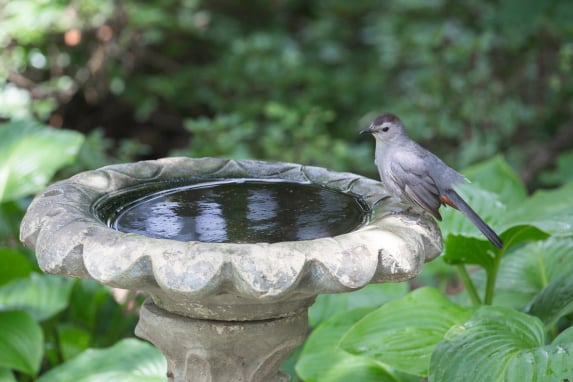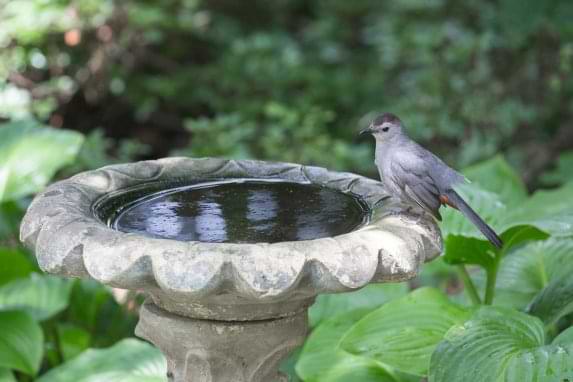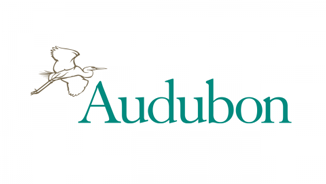
Posted March 10th 2020
How to Make A Bird Safe Backyard This Spring

Posted March 10th 2020
How to Make A Bird Safe Backyard This Spring
An astonishing 1 billion birds are killed every year in North America. The cause? Windows. Our skyscrapers and condos might be a sign of our architectural prowess, but our beautiful glass buildings are the second leading cause of death for the birds who share the skies with them.
At Feather Friendly® we’ve manufactured a solution to the window problem by developing Bird Deterrent Technology for residential and commercial structures. The result? Bird safe glass. However, did you know there are other ways you can contribute to various bird conservation efforts? That’s why we’re welcoming spring by giving our fellow bird-lovers and homeowners a few tricks to make their yards a bird-friendly oasis. Because when you welcome spring, you also welcome many migratory birds, too.
Native Plants
When you see a hummingbird sipping nectar from a flower, a vireo plucking a caterpillar from a leaf, or an oriole gobbling down a berry, it’s clear that the relationship between bird and plant can be vital to each.
It’s easy to think of animals as scavengers that will eat anything they can find, but BirdLife’s comment on the relationship between birds and plants illustrates how animals and plants are constantly interacting with each other in complex ways. That’s why you should choose carefully when replanting your yard.
So, what exactly is a native plant? According to Audubon, native plants are species that naturally occur in a specific geographic location, which is the one they originally evolved from. These native plants, after taking “root” in a specific part of the world, constitute an “ecological basis” for other native species who have also evolved in that area (including humans and animals). Evolution of insects and trees happen simultaneously and are therefore connected to the local bird populations that depend on plants and insects for food and shelter.
A diverse range of native species can entice a host of new species of bird into your yard, while lending support to existing bird residents, too. If you’re unsure about what plants are native to your region, simply enter your zip code into this database or, if you’re in Canada, search for plants native to your province.
Benefits of native species:
- Low maintenance and adjusts to the environment
- They store and eliminate greenhouse gases
- Provide vital habitats and resources to numerous species
- Aesthetically pleasing
- Environmentally conscious
While a well-kept lawn is a thing of beauty, artificial turf or chemical treated blades of grass will do little for biodiversity.
Nesting Material
Many bird lovers are tempted to provide yarn, dryer lint, and animal/hair clippings to nesting birds. There’s something exciting about seeing a sparrow or robin use your old ribbon to build its nest. But, well-meaning intentions aside, most of these materials are toxic to birds. Even materials that we think are harmless and natural, like hair, string and dryer lint, can impact bird health.
The Cornell Lab of Ornithology advises against providing any of the following:
- Plastic or fabric strips
- Tinsel
- Dryer lint
- String
- Human and/or pet hair
But this doesn’t mean you can’t help your fluttering neighbours take up residence in your old apple tree! John Rowden, Audubon’s director for community conservation, and Jennifer Gordon, the executive director of Carolina Waterfowl Rescue, list several excellent options that are abundant and easy for you to collect and provide to birds for nest building! Leaves and twigs are a great choice for birds. Pile and leave around your yard—the birds will do the rest. Grass clippings are an ideal nesting material, too. Instead of giving your clippings to the garbage man, leave them for the birds! However, this option is not suitable for lawns that have been treated with chemicals, so be careful. Remember those native plants you planted? Another great benefit of common plants is that the pine needles, plant fluff or down, moss, and bark give birds a variety of materials that they can pack their nests with.
You can present these materials to your backyard birds in any of the following ways or leave as-is and let nature do its thing!
Bird Baths & Feeders
As if your native plants weren’t tantalizing enough on their own, you can try adding a bird feeder, a bird bath, or both, to attract other species of birds to your yard.
Did you know? Maintenance and placement of bird baths and feeders can protect birds from predators and disease.
Here are some best-practices to follow so that you can keep your backyard visitors healthy!
When selecting your feeder: choose an enclosed style that prevents birds and other animals from spreading bacteria to the food. By keeping the seeds contained, you’ll increase the freshness of the food and prevent illness from spreading.
Placement of Feeder: Feeders should never be placed close to untreated windows where birds are vulnerable to collision. It’s best to place feeders in a high, sheltered area that will 1) protect birds from predators, and 2) provide your feathered friends with an easy escape route! This is especially important if you have a cat that you allow outdoors.
When selecting a bird bath: You might think that all bird baths are made equal, but you’ll need to select the right one for your yard. Larger baths may accommodate more birds but, if your backyard has a critter problem, the birds might not be the only ones using it!
Homeowners should opt for a bird bath that holds no more than two inches of water, since anything deeper is unappealing for smaller birds. If you do have an existing bird bath that’s on the deeper side, you can add a few rocks or a small perch to give your birds a place to drink comfortably. It’s recommended that you select a bird bath that’s easy to clean, and one that you like the look of! If you enjoy the look of your bird bath, you’ll be more likely to maintain it. Opt for a style that will blend in with your yard or garden to create the ultimate habitat.
Finally, just like bird feeders, bird baths should always be placed in a sheltered area that gives birds an excellent “bird’s eye view” of predators!
Apply DIY Bird Tape for Windows
Homeowners can also use Feather Friendly® Bird Deterrent Technology to prevent window collisions and keep backyard birds safe. When you attract new wildlife species to your yard, it’s important to ensure that your space if safe for them. So, to keep the birds flying, order DIY tape for your windows! Plants and birdfeeders that are positioned close to your home can be dangerous for feeding and nesting birds. In fact, a startled or territorial bird may collide with the window without realizing it’s there. Often mistaken for window films, which is a full window coverage product, Feather Friendly® DIY bird tape are individual markers installed on the outside of windows to make them more noticeable to birds, without obstructing your outside views or natural light.
Welcome Spring
So, even if your lawn is still blanketed in snow, you can get a head start on spring by incorporating some of these fun ideas into your gardening routine! Make your yard bird safe and attract birds by planting native plants, setting up feeders and bird baths, and by keeping your cat indoors!
And don’t forget to do your part by installing Feather Friendly® DIY bird tape to keep your local birds safe from window collisions. Want more information? Visit us online and contact us today!
Partners
We are honoured to form partnerships with organizations who demonstrate
an ongoing commitment to bird conservation.



